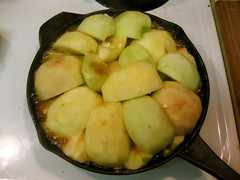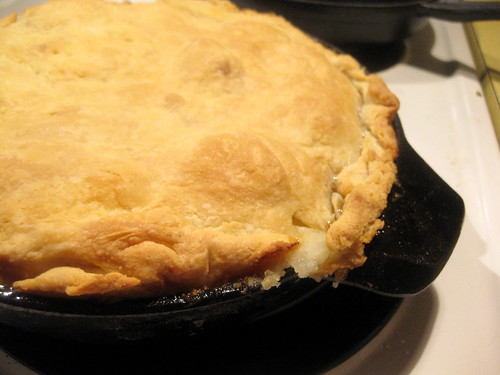Valentine’s Day! The two words conjure images of overpriced roses, expensive and hard to get dinner reservations, lacy lingerie and dark chocolate. To a lot of my friends, it also means “corporate swill,” “time for alcohol” and “grumpiness.”
I am in neither of these camps; I actually like February 14th. I like telling all my single friends how much I love and appreciate them, giving out candy to my coworkers and using those chalk-like candy hearts as writing implements. But with Christmas, New Year’s, my birthday at the end of January, Reid’s last Wednesday, and my best friend’s on the 11th, I have to admit: I was a little gifted and partied out.
So, no braving our town’s many delicious (and overbooked) restaurants, no trying to find a parking spot for 20 goddamn minutes, no annoying-trophy-moms-asking-our-favorite-barstaff-for-another-pinot! Last night, Reid and I made our Valentine dinner after a quick trek to the grocery store.
Which brings us to the Apple Tarte Tatin. Honestly, before I found it in Amanda Hesser’s (amazing) The Essential New York Times Cookbook, I had no idea what a tarte Tatin even was, let alone tasted one. Reid had never either, and he even lived in France (he blames this on the fact that tarte Tatins don’t look especially exciting in French pastry cases next to almond croissants, tiny crème brûlée, cheesey quiche and what he dubs “big gooey pastries.” He also says this makes him “kind of a douche”)! I just quizzed him about what he craved for dessert and he replied simply with, “Apple tart?”
Apple Tarte Tatin is so surprising and delicious. It is so effing simple, so brilliant and you probably have most of the ingredients sitting in your pantry right now. You don’t even need a tarte Tartin pan! My favorite part is when the boyfriend handles a cast iron skillet and plate with such grace and fluidity, that when he uncovers the beautiful pastry, you just want to kiss him. (Ours was a little burnt on the top, but it was still pretty.)
Eating it isn’t so bad either. It’s not overly sweet, juicy with amazing notes of golden caramel, which contrasts so wonderfully with a dollop of crème fraiche. It makes you definitely not regret trying to go out. This is also great the morning after Valentine’s Day (or after any day you make it).
Apple Tarte Tatin
Adapted from The Essential New York Times cookbook
For the pastry (for 2 tartes Tatin):
2 cups all purpose flour
1 teaspoon salt
1/2 pound (2 sticks) unsalted butter, cut into small pieces and chilled
1 large egg yolk, whisked together with 2 tbls water (I actually ended up using about 4 more tablespoons of water more to keep the dough together)
Combine the flour and salt in a large bowl. Add the butter and rub the flour and butter together between your fingers until most of the butter is incorporated and only pea-sized pieces remain (you can also use a pastry cutter here as well). Add the egg yolk mixture and stir until the dough begins to come together. If it doesn’t come together right away, add cold water a little bit at a time until it does.
Use your hands to gently press the dough into a ball. Cover and refrigerate until firm but not hard, about 30 minutes (if making ahead, let the dough stand at room temp until pliable but still cold). Do not roll out until just before the tarte Tatin’s fruit is finished cooking.
Makes enough for 2 tartes (can be frozen, well-wrapped, for a month).
The actual tarte:
4 large Granny Smith apples
4 large Pink Lady apples
2 tablespoons fresh lemon juice
3/4 cup sugar
1/2 recipe Tarte Tatin Pastry (see above!)
crème fraiche for serving (optional)
Position a rack in the bottom third of the oven and heat the oven to 375º. Peel, quarter and core the apples. Place in a large bowl and toss with lemon juice, set aside. Place the sugar in a 10-inch skillet or tarte Tatin pan over low heat. When some of the sugar begins to melt, begin stirring with a wooden spoon till all the sugar is melted and begins to turn a pale golden color.
Remove the pan from the heat. Begin arranging the apple pieces in the skillet, rounded side down, in concentric circles, fitting them as close together as possible. Fill the center with 2 or 3 apple pieces, as needed. Arrange remaining pieces, rounded side up, in concentric circles on top of the first layer, fillling in the gaps. Cut the butter into small pieces and scatter over the apples.
Place the pan over medium heat and cook until the sugar turns a deep caramel color and the juices released are nearly evaporated, about 15-20 min. Remove from heat.
Flour a work surface and a rolling pin well. Pat your dough into a disk with your hands. Roll the dough into a circle that is 1/4″ thick and 12″ wide, flouring the surface under the dough and the rolling pin to prevent sticking. Carefully place the pastry round over the fruit in the skillet. Trim the dough to 1/2″ larger than the skillet and tuck the overhanging dough in around the fruit.
Bake until the the crust is golden brown, about 25-30 minutes. Remove from oven and let rest for 10 minutes.
Run a small sharp knife around the edges of the tarte to loosen. Place a large plate or platter over the skillet. Using 2 kitchen towels, hold the plate and the skillet together and carefully but quickly invert the tarte on the plate. Let stand for a few minutes to cool slightly. Cut into wedge and serve with crème fraiche, if desired.
Cooking notes: We used a 10″ cast-iron skillet; people have had success with stainless steel All-Clad and of course actual tarte Tatin pans. Having never made one of these before, Reid was kind of skeptical about cutting the apples into quarters. “Doesn’t it seem kind of chunky? Like we should be making slices?” Obviously, we left it up to Amanda Hesser and Molly O’Neill and they didn’t steer us wrong. Slices wouldn’t have held up to the caramelizing and turned into mush.
Apparently, the traditional French choice for this are Golden Delicious apples. We used 1/2 Pink Lady and 1/2 Granny Smith and it wasn’t too sweet. The recipe calls for Granny Smith, but I think any apple that is firm and flavorful will do ya good. We also didn’t use all the apples, but we got huge ones.
I recommend putting the cast iron skillet on a baking sheet when you put it into the oven (we didn’t, and got buttery apple juice on our oven floor). Get someone more coordinated than you to flip the tarte onto your serving plate if you feel nervous.
Also: revel in its buttery, sugary, appley glory as it boils away on your stove. We did.







3 responses so far ↓
Linda // March 26, 2011 at 9:43 pm |
WOW! Looks SO Yummy!
Love the Blog!
Tycho // March 16, 2011 at 9:04 pm |
dam them shits look tasty yo
Aileen // February 22, 2011 at 1:38 pm |
that looks amazing. i expect at least two to be waiting for me whenever i arrive at your house. fact.